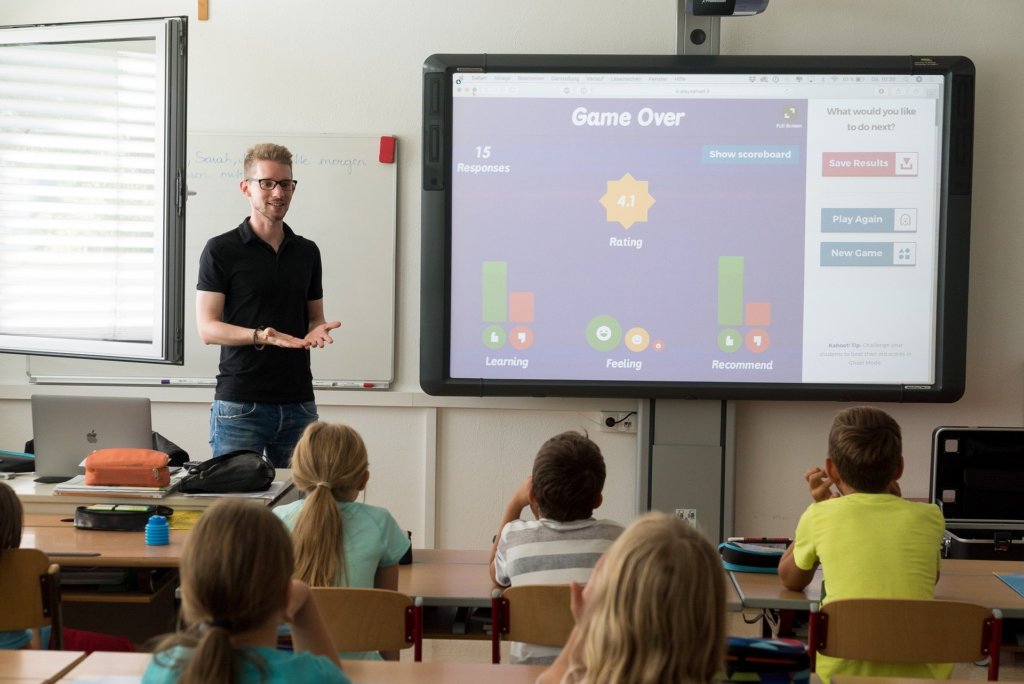Have We Made Any Progress on Classroom Noise Levels?

It seems as though educational audiologists have been talking about noise levels in classrooms for decades, but have we made any progress in reducing them? Despite decades of research, professional standards and guidelines, and advocacy, it is not clear that classrooms are quieter or represent better listening environments today. We might have the nostalgic view that back in the days of student desks in rows and different teaching styles of the 1940s and 1950s, classrooms were quieter, and there was no concern about the listening environment. Not so. There was some discussion of design principles for school construction which referenced acoustics in the 1940s, and research investigating the impact of the listening environment on students can be found beginning in the 1950s.
An excellent example is the 1952 doctoral dissertation by Jacob Brynes entitled “An Evaluation of Classroom Speech and Noise Levels in Terms of Speech Intelligibility Implications.” It began with the statement, “This investigation stems from a curiosity about the fluctuation of speech Intelligibility in classrooms and a desire for its improvement. When information is lost in passing among a classroom’s inhabitants, an educational loss is likely.”1 This author recommended a signal-to-noise ratio of at least +10 dB, but found that few classrooms achieved this consistently. He noted that “…the speakers showed a consistent compensatory behavior in attempting to override louder noise by still louder speech.
Nevertheless, this compensation was only partly successful since the ratio decreased with every increase in noise.”1 Brynes’ phrasing may sometimes sound a bit old-fashioned to a 21st-century reader, but all of his findings, observations, and recommendations are as true and relevant today as in 1952. In The Fallacy of the Teacher Voice, Yuskow reminds us that this idea that teachers can somehow project their voices as an effective strategy is not true.2, unfortunately, 70 (!) years after Brynes pointed out that talking louder does not improve the signal-to-noise ratio in classrooms, audiologists are still fighting this battle.
Architectural trends have changed over the years; in 1970, Fitzroy reported on ten years of experience with the listening environments of open plan classrooms (hint: open-plan classrooms did not solve the problem of classroom noise).3 Various recommendations have been made to ameliorate the problem after building construction, including carpet (generally not allowed in present-day classrooms due to allergies and cleaning concerns), acoustic tile (expensive), or hanging soft materials around the classroom (potentially a fire hazard). Curiously, one author has advanced the hypothesis that extroverted teachers were better able to cope with classroom noise and that this might be a strategy.4 However, as recently as this year (2022), research on classroom acoustics continues to document the same poor listening environments that were of concern to Dr. Brynes in 1952.5 In Canada, the Concerned about Classroom Coalition has advocated for more attention to classroom acoustics for many years. Pre-COVID, in 2019, the Elementary Teachers Federation recognised classroom noise as a barrier to teaching and learning in its document entitled “Noise in Classrooms: Preventing the Effects on Health and Interference with Learning.”7
As of January 2022, schools across Canada have generally returned to in-class learning following many months of switching between in-class and online learning in the COVID-19 pandemic. However, this means that classroom listening environments are potentially even more problematic. While masks, social distancing, and increased ventilation are all necessary pandemic measures, they can make for a difficult listening environment for students and teachers, something I recently wrote in The Conversation about advocating for more sound fields in classrooms.8 Pre-COVID, we know that classrooms already represented less than optimal acoustic environments.9 Is it possible that classrooms are getting even noisier due to COVID? As of August 2021, the Ontario Ministry of Education invested 550 million dollars to improve school ventilation10; however, ventilation systems potentially add another noise source. While the memo mentions that “Noise rating of a unit should be considered,” no guidance is provided regarding recommended noise levels. A 2007 study of noise levels in HVAC systems in classrooms indicated that most systems had noise levels that exceeded acoustical standards.11 Policies on ventilation, such as the recent May 2021 report from the John Hopkins Center for Health Security, are focused on air quality.12 However, the report touches on the issue of noise, noting that “Louder units are cheaper, and some jurisdictions may opt for the cheaper units, especially if the quiet ones are sold out, but the additional noise may disrupt learning, which would generate hard-to-quantify costs.” Indeed. “Hard to quantify costs” such as those to student learning and teacher health.
This adds up to students having difficulty hearing the teacher and their classmates. Having to raise one’s voice to counteract the effects of masks, distance and noise is hard on teachers’ voices as well.13 Anecdotally, teachers are experiencing voice problems due to the necessity to raise their voices for students to hear them14; some teachers are purchasing their own portable speaker systems, and some school systems are installing sound field systems as a response to the pandemic.15 In 2004, Smaldino and colleagues wrote an article entitled “The Complimentary Roles of Audiologists and Acoustic Consultants in Solving Classroom Acoustic Problems,”16 in which they made the point that these two professionals together bring the required knowledge and skills to solve this problem. In 35 years of practice, I have not experienced this collaboration, but this may be the time for renewed efforts in this area.The pandemic has brought new attention to the issue of barriers to communication, as people without hearing or communication disorders are also experiencing difficulties interacting with others and therefore have more personal insight into the frustration and impact of not being able to hear what someone is saying.17 Perhaps this will spark new conversations about classroom listening environments.
References
- Brynes J. An Evaluation of Classroom Speech and Noise Levels in Terms of Speech Intelligibility Implications. New York University. ProQuest Dissertations Publishing; 1952. Available at: https://www.proquest.com/openview/03d4fea0a8e123babd105f6633967927/1?pq-origsite=gscholar&cbl=18750&diss=y
- Yuskow K. The Fallacy of the Teacher Voice. Can Aud 2020; 7(5). Available at: https://canadianaudiologist.ca/issue/volume-7-issue-5-2020/column/in-the-classrooms/
- Fitzroy D and Reid JL. Acoustical Environment of School Buildings. Available at: https://scholar.google.ca/scholar_url?url=https://files.eric.ed.gov/fulltext/ED031070.pdf&hl=en&sa=X&ei=2tMXYv27NMWUywTWzou4BA&scisig=AAGBfm02WT65GvWgSy9My05NBPW_yOyGwA&oi=scholarr
- Oseland N. Open Plan Classrooms, Noise & Teacher Personality. Workplace Unlimited; 2018. Available at: https://scholar.google.ca/scholar_url?url=https://files.eric.ed.gov/fulltext/ED031070.pdf&hl=en&sa=X&ei=2tMXYv27NMWUywTWzou4BA&scisig=AAGBfm02WT65GvWgSy9My05NBPW_yOyGwA&oi=scholarr
- Massonnié J, Frasseto P, Mareschal D, et al. Learning in noisy classrooms: children’s reports of annoyance and distraction from noise are associated with individual differences in mind-wandering and switching skills. Environ Behave 2022;54(1):55-88. https://doi.org/10.1177/0013916520950277
- Concerned About Classrooms Coalition. No provincial building standards regarding classroom acoustics currently exists across Canada. CASLPA. Available at: https://www.sac-oac.ca/sites/default/files/resources/noise%20in%20classroom%20backgrounder.pdf
- Elementary Teachers Federation of Ontario. Noise In Classrooms. Author; 2019; Available at: https://etfohealthandsafety.ca/site/wp-content/uploads/2019/06/Noise-Lobby-Booklet.pdf
- Millet P. Masks and Other Pandemic Measures Are Necessary at School, But Can Make It Harder To Hear In Classrooms. The Conversation. 2022. Available at: https://theconversation.com/masks-and-other-pandemic-measures-are-necessary-at-school-but-can-make-it-harder-to-hear-in-classrooms-174591
- American Speech-Language-Hearing Association. Classroom Acoustics. Available at: https://www.asha.org/public/hearing/classroom-acoustics/#:~:text=Two%20things%20cause%20poor%20classroom,many%20places%2C%20including%20the%20following%3A&text=Sounds%20from%20inside%20the%20building%2C%20such%20as%20students%20talking%20in%20the%20hallway
- Ontario Ministry of Education. School Ventilation. Available at: https://efis.fma.csc.gov.on.ca/faab/Memos/B2021/B14_EN.pdf
- ATS&R. Classroom Acoustical Study. 2007. Available at: https://www.ahrinet.org/App_Content/ahri/files/standards%20pdfs/Classroom%20Acoustical%20Study.pdf
- Olsiewski PJ, Bruns R, Kwik Gronvall G, et al. School Ventilation: A Vital Tool to Reduce COVID-19 Spread. Johns Hopkins Center for Health Security. 2021; Available at: https://www.centerforhealthsecurity.org/our-work/pubs_archive/pubs-pdfs/2021/20210526-school-ventilation.pdf
- Kishbaugh KC, Kemper CE, and Altman KW. J Voice. 2021 Nov; 35(6): 813–814. doi: 10.1016/j.jvoice.2021.04.001
- East Tennessee State University. Professor providing voice tips for teachers wearing masks. Author; 2020: Available at: https://www.etsu.edu/etsu-news/2020/09-september/voice-tips-for-teachers.php
- Featherstone CH. Bluetooth Audio Amplification Helps Teachers Be Heard. Govt Tech;2021. Available at: https://www.govtech.com/education/k-12/bluetooth-audio-amplification-helps-teachers-be-heard
- Smaldino JJ, Doggett F, Thunder T. The complimentary roles of audiologists and acoustic consultants in solving classroom acoustic problems. Semin Hear 2004; 25(2): 179-188. DOI: 10.1055/s-2004-828668
- Ong S. How face masks affect our communication. BBC; 2020: Available at: https://www.bbc.com/future/article/20200609-how-face-masks-affect-our-communication


